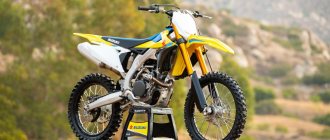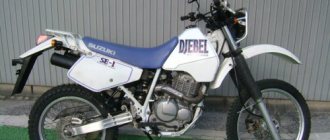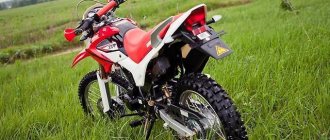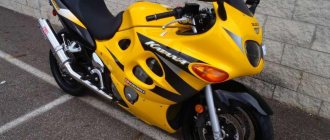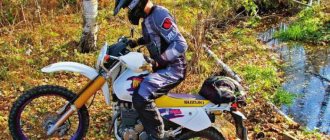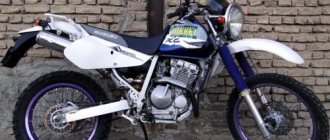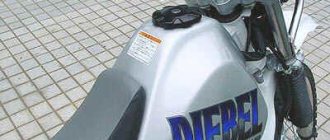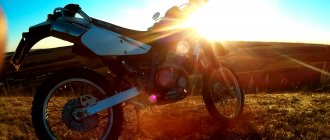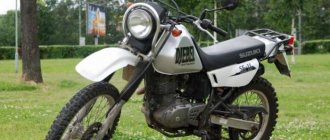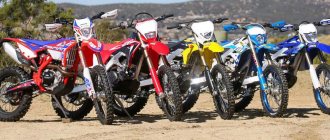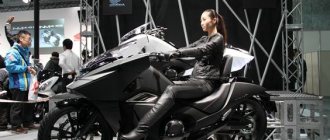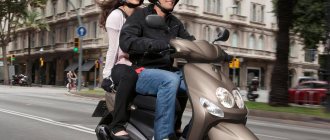Japanese motorcyclesSuzuki motorcycles
Nowadays motor vehicles of different directions are produced.
For active recreation and riding on roads of varying quality, companies offer Enduro class motorcycles.
Moreover, to overcome off-road conditions and travel in different road conditions, it is not necessary that the motorcycle have a powerful power unit.
A good representative of the Enduro class is a motorcycle from the Japanese company Suzuki named Djebel 200.
The main thing for Enduro is a simple and reliable design.
The Suzuki Jebel 200 first appeared in 1993.
It replaced the SX 200 R model, its factory designation was SH 42 A. Initially, it was sold only on the domestic market .
Later, this bike began to be offered in European countries, where it was designated DR 200 SE.
This motorcycle was so reliable and had a simple design that this ensured its popularity, so it was produced without any special changes in the design until 2005.
006_MOTO_0310_042
The oil cooler becomes clogged with dirt flying from the front wheel, but this has almost no effect on engine cooling.
The oil cooler becomes clogged with dirt flying from the front wheel, but this has almost no effect on engine cooling. The old TM28 carburetor is often criticized for its “low-end failure” and praised for its “sporty top end.” The new BSR32, on the contrary, is “lucky” from the “bottom” and slows down at the “top”. In fact, the old carburetor is not so bad, you just need to correctly adjust the idle speed - and according to the factory recommendation, they are quite high - 1500-1700 (!) rpm. Therefore, if you hear individual flashes when purchasing, do not hesitate to set the “threshing” speed before the trip. With both carburetors, fuel consumption on the highway is within 4–5 l/100 km, i.e. The tank lasts for 300–400 km.
But the most effective means of fighting for traction at the bottom remains “playing” with the stars. The standard 14-42 kit is more or less suitable only for asphalt driving. For light plein air rides mixed with asphalt, the optimal ratio is 13–42, and for hard off-roading and fully loaded outings, we can recommend 13–49—the standard option for the DR-Z250. However, in the latter case, you will need to remake the chain trap. Another bonus for “dowel drivers” is that the drive sprocket is fixed on the gearbox shaft with a simple retaining ring, and not with bolts or a nut, as on most endurics, so replacing it in the field will only require the presence of a retaining ring remover (pliers). The whole operation takes about five minutes, including resetting the chain tension.
You can often hear negative feedback about the operation of the gearbox: it shifts hard, the neutral is difficult to catch... In the vast majority of cases, this is not a design flaw or wear and tear. The “dowel” box is extremely sensitive to the quality of the oil, and its jamming is the first sign that it is time to change the oil. The approximate service life of “synthetics” is 3–5 thousand km, semi-synthetics – up to 3 thousand km. But in hard off-road conditions, of course, you need to do this more often. Another feature of the gearbox is reliable gear locking. It not only allows you to avoid accidental switching while driving (and this is very unpleasant on off-road), but also saves the box itself from overloads
When checking the motorcycle while driving, pay attention to the operation of the speedometer. At the “dowel” it is driven by a cable, which often breaks
But this is not so bad - a modified cable from a VAZ-2107 (70 rubles) is suitable for replacement, but the crumbled gears of the gearbox will require replacement of the assembly. This is a reason for bargaining.
Video
- Review of the Suzuki Djebel 200 motorcycle from the owner.
- Brief inspection and launch of the Suzuki Djebel 200 motorcycle.
The world of motorcycles is diverse. Some people need choppers, others need sports bikes... After all, everyone chooses equipment to suit their personal needs. Off-road enthusiasts, for example, prefer enduro, and the motorcycle that we are going to talk about now will go where even a tank would get stuck. This is one of the bikes that amazes even experienced drivers - this is the Suzuki Djebel 200
.
In 1993, the manufacturer launched this model for sale, and, interestingly, the bike was initially intended exclusively for the Japanese market. However, cunning sellers quickly realized that they would willingly buy the Djebel 200 in European countries, and sent two hundred of these motorcycles to Europe for testing. The experiment justified itself - the batch sold out like hot cakes, and the decision was made - the Suzuki Djebel 200 went on mass sale, becoming a competitor to the Yamaha TW 225.
The design of this technically conservative motorcycle remained unchanged until 2005. Of course, if you don’t count a small change in 1996, when the company slightly changed the headlight on the Djebel 200 and put a new sticker on the gas tank. Modifying this model was considered an unnecessary undertaking, since it was simple, reliable and coped with its main task - conquering off-road conditions.
The technical characteristics of the Suzuki Djebel 200 are as follows:
There is a telescopic fork at the front and a monoshock at the rear. The suspension, by the way, is very energy-intensive, and the steel frame has a significant margin of safety.
There are protective arches installed on the steering wheel, but this is not found on all copies, because... this is an additional option.
The gas tank is of a peculiar triangular shape, with a volume of 13 liters. Its capacity is quite enough, which sometimes puzzles novice motorcyclists, since on average only 3.5 liters of gasoline are spent per 100 kilometers. The motorcycle readily digests AI-92.
Acceleration to 100 km/h is ten seconds.
The pilot can easily fit on the seat along with the second number. Part of the seat is on the gas tank. However, who rides enduro together?
The cooling system is combined. Thanks to this, you can ride long distances at speeds close to the maximum speed for this motorcycle, while the Djebel does not risk overheating. At low speeds in the mud it also feels confident.
The engine is four-stroke, cylinder head is two-valve, with a power of 20 hp. and with a torque of 18 Nm.
The front wheel has a single-disc brake system, the rear wheel has a drum brake, unfortunately, and it would be hard to call it effective.
The Djebel 200 is a lightweight motorcycle, and this, while an advantage outside the roads, becomes a disadvantage on the highway - it simply blows away in a strong side wind.
Hello. Feeling a steady craving for freedom of movement throughout life, I search for the way to it by touch.
For several years now, the motorcycle has been a part of my life. In a big city, I chose two wheels, first of all, to be able to feel like a human being for at least half a year, and not a happy element of a dynamically developing urban system. Of course, the bike is also about emotions from the process. But, squeezed by the rules and common sense in heavy traffic, I rather enjoy the time saved on the road.
The tenacity with which effective city managers are changing my city is worthy of praise. Increasingly, you are wondering whether to spend your free time away from bus lanes, paid parking lots, courtyards clogged with cars, and from the city in general. Having renounced cars, Moscow began to quarrel with motorcycles, narrowing the lanes and hanging cameras in the tail. Motorcycle travel has become a new outlet in search of freedom.
Russia lives freer outside the Moscow Ring Road. The wealth of choice of interesting places to travel makes your head spin. Federal highways will lead you to almost any regional center, where tourists will be sold a Chinese magnet and a Big Mac. You need to turn aside to the real beauties. The result of the work of not so effective regional leaders is not worthy of praise, but strangely the result is close to the capital. The amount of infrastructure available per person is slightly more than zero. There are no traffic jams, but there are no roads either. The limited freedom of movement on a road motorcycle in our country is becoming obvious. Here they are, they are beautiful, close by, but try to drive up. For the first time I’m thinking about more suitable transport.
Here it turns out that, on the instructions of far-sighted marketers, smart engineers have already thought of everything. An excellent choice for an adventure-seeking urban romantic should be an uncompromising crossover that has everything: comfort, power, 21 wheels and huge trunks. The complete lack of charisma was embarrassing, but in the forests there was no one to impress.
While studying the topic on YouTube, I came across a strange pattern - videos with touring enduros differ little from videos with RTs and GoldWings. It’s a bit boring, with the exception of the funny falls of equipped riders of monumental geese in ruts from SUVs and the heroic attempts to rescue formidable adventurers from harmless puddles 10 meters from the highway. The subsequent trip on the 900th Tiger confirmed the guess. Only pro-riders from advertising can conquer directions on a high 200+ kg motorcycle, but in real life, a tourenduro seems to be an excellent accessory to Timberlands and will add little to freedom of movement.
It was much more interesting to watch how the “light endurists” fervently rush along any trails and carelessly throw their XRs, KLXs and other TTRs down the hill. An off-road “check” with numbers is what I need.
I started searching. I was not happy that I was not yet ready to give up my “street” in favor of a single small-capacity model for all occasions. This means I’ll buy a second bike, and this is an extra investment. Therefore, we set a modest budget. I liked the new, inexpensive Chinese, but decided to play it safe and paid extra for an elderly Japanese. Yes, he was 12 years old, but he looked like he was 30, but for some reason he inspired a feeling of confidence, like an experienced grandfather on a mushroom trip.
I bought the Suzuki Djebel 200 without hesitation when I saw it in person. Round headlight, mirrors, tidy and turn signals, front fender with a hook, rear fender with a shovel, in short, the complete feeling of a solid thing, tested by time. This one definitely won’t whine on any country road. I was a little confused about how to drive it around “civilization”?
It turned out that in the city this little hunchback was jumping like a hare. It starts vigorously, changes lanes and goes where not every bike can. In traffic jams it will run away from any Hayabusa. The main thing is not to be afraid - there are no brakes on it. The front disc is decorative, the rear drum has two positions on and off.
On the highway the mood is different. We keep 80, follow the trucks, observe the scenery. If you live far from big roads or a radically Nordic warehouse, then you can even get high. Soft ride, wide saddle, endless tank (I used to ride 480 km on it) and a feeling of every mechanism working. It can be cranked up to 120, but the groan of the engine at high speeds is absolutely unbearable. In general, long-range shooting is possible, but it is contraindicated for the nervous system of a busybody like me.
Therefore, I moved him to the dacha closer to the places of future hikes. Instead of expanding my movement halo, I simply supplemented it.
And off we go. I took every opportunity to ride because I loved it. He fell, rose and fell again. The motorcycle easily endured abuses unimaginable for road vehicles. Some kind of childish delight - I can go wherever I want. Bumps, clearings, fords, clay, primers. A constant feeling of fighting with technology and nature. Complete immersion in the process, something I haven’t experienced for a long time while riding on flat roads.
The device, as expected, turned out to be well thought out and adapted. The engine has no tops, but it pulls like a tractor. The saddle, which is low even for my 172 cm, allows me to substitute my leg at any time. Very soft suspension allows me to rush across fresh arable land while sitting, and the brakes are now sufficient.
At some point I felt that I had reached a decent level of skating. All the surrounding areas had been explored by this point, and I didn’t really want to travel far on the jab. Interest in such enduro began to fade. I began to notice shortcomings: difficulty starting after inactivity and at low temperatures, sluggish throttle response, geometry not intended for stand-up driving, disgusting exhaust sound. And then my enduro accomplice offers to go to the competition. There is, he says, a “hobby” class, let’s show what we can do. My excitement and thirst for adventure awoke again.
We loaded the bikes into a pickup truck and drove off merrily. I don’t want to describe what happened next in detail. In short, I realized that I can do absolutely nothing. I am not able to pass any more or less endurous obstacle. All I could do was leave the race on time and maintain my technique. Well, it’s also a lot of fun for the rest of the participants. This motorcycle probably didn’t experience so much attention even when it was first shown to the public in 1993. Owners of KTMs, WRs and even Avantis twisted their fingers at their temples, patted them on the shoulder and advised them to go home.
I guessed that Djebel 200 is clearly not for logs, rocks and cliffs. But the fact that I am a complete zero, as an endurist, came as a surprise to me. New boundaries of freedom of movement appeared within me.
Two weeks ago, Jeb easily sold himself to a man who would ride him to pick mushrooms. And yesterday I bought myself a “new Chinese KTM” without a title or obligations to the state. 7 years after my first lessons, I again wanted to learn how to ride a motorcycle. The ability to move not only along any road, but in any direction seems to be a new goal.
"Pasaremos!"
005_MOTO_0310_042
After modernization in 2000, Djebel acquired a constant vacuum carburetor, and a kickstarter became standard. After modernization in 2000, Djebel acquired a constant vacuum carburetor, and a kickstarter became standard.
The Djebel engine, like many Suzuki air vents, is noisy. When you stop, sometimes you hear a terrible clattering noise - this is also normal, don’t worry. The engine has an automatic decompressor installed, so it will not be possible to measure the actual compression in the cylinder. The only way to check is on the go (of course, if you have enough experience in your arsenal and the owner allows it). In general, the engines run here for a very long time (there is experience of 100–150 thousand km), but they are demanding on the quality of oil and air (the cylinder is nickel-silver). Therefore, keep an eye on the air filter (it is impregnated with foam rubber). And the slightest noticeable leaks at the inlet are a reason to refuse the purchase. Valve clearances are adjusted with washers (they will have to be ordered after measuring the clearances), but the complexity of adjustment is compensated by its relatively rare need (as a rule, this is 20–40 thousand km). By the way, a leaking cylinder head gasket usually indicates that the head has been opened.
Does color matter?
At first, the motorcycle was in demand mainly among the rural population, then they began to paint it in brighter colors and the situation leveled off; the Jebel 200 was now also purchased by urban residents. Of course, each buyer had his own stereotypical approach, some liked the orange camouflage, while others preferred more modest colors. However, everyone agreed on one thing - both villagers and city dwellers would like to purchase a reliable, trouble-free motorcycle, and what color, this can be discussed later.
The bike was produced for some time as the Jebel 250, but soon production completely switched to the Jebel 200, since the fuel savings were significant. And this option turned out to be the most successful, the production of the “200th” continued for quite a long time, and not only for reasons of low gasoline consumption - there were also a number of arguments in favor of the “200th”, one of which was the reliability of the design.
The motorcycle was not intended for racing either around the circuit or over rough terrain. It was a simple machine for easy operation under normal conditions. However, it turned out to be difficult to resist rushing along a good highway, especially for a young motorcyclist. The speed of the Jebel 200 was decent and was about 180 km per hour. Some owners even organized mini-competitions among themselves, just to test the technical capabilities of the car. And the motorcycle never let me down.
A brief excursion into history
For the first time, the Suzuki Djebel 250 was presented to a wide audience in 1992. Created on the basis of the DR series motorcycles, it received all the best from them - an air-oil-cooled engine and took on a little appearance. But unlike its predecessors, engineers replaced the fork and installed a large headlight in a protective housing.
One of the main advantages of this Suzuki enduro is that from the beginning of the new century they began to install a kickstarter in the base model. In the early years, a kick starter was not installed on this bike - it was considered an additional option. Also, until 2000, this bike was equipped with a TM28 carburetor, which did not prove to be the best (it worked poorly at low speeds). Therefore, in 2000, it was decided to replace it with a more modern BSR 32 carburetor, which began to work stably at low speeds, but at high speeds (according to professionals) it began to “slow down”.
Due to stricter environmental requirements for cars and motorcycles in 2008, the Suzuki Djebel 250 was decided to be discontinued.
Reviews of Suzuki Djebel Rating: 5 out of 5 2 reviews found
05.09.2017
An all-round excellent motorcycle for beginners and moderate rides for the soul, but first things first. This is a junior model for the domestic Japanese market and it is radically different from its older brother. What is noteworthy is that in 2015 it was still produced in Japan, although my device was born in 1994. I won’t go deep into the performance characteristics; you can already find them on the Internet. And so, this motorcycle appeared to me as the first adult motorcycle after mopeds. There were a lot of impressions, but now I’m writing a review having tried other and more interesting motorcycles, so I will judge quite objectively. The appearance is a classic enduro, no frills and beautiful. In the photos from the additional one there is only hand protection. Of course, it has some kind of beauty, but it is discreet and emphasizes its utilitarian nature. The engine is a very reliable engine with one overhead camshaft and two valves. Modern snow leopards TTR 250 and its clones are equipped with copies of its engine, but with small deviations and cylinders increased to 250 cubic meters. The engine is not forced and unpretentious and this is its main advantage. It has legendary efficiency - from 3 liters per hundred and a very spacious tank. The engine itself pulls confidently from low speeds, but even at high speeds everything is smooth. There is enough traction both on and off-road. It goes uphill confidently if you keep the revs and use the right gear. We can say about the box that it is good! Five gears, well-chosen gear ratios, shifts are clear and precise. Repair, maintenance and adjustment do not require super preparation due to the simplicity of the design, access to the components (engine, oil and air filter, spark plug) is excellent - you do not need to disassemble the floor of the motorcycle to change the spark plug. This motorcycle is all about reliability. For a short period of three full seasons, we were up to our ears in mud. The main thing is to monitor the oil in the crankcase and the lubrication of the chain and cables. During this time, in the old car I only changed the oil, sometimes washed it, and in the third season I replaced a leaking oil seal and a stretched timing chain. And in principle, it did not break down at all and never failed! And even after two years in the hands of another owner, I see him and know that everything is fine with him and he runs around and pleases his new owner! Ergonomics are at a high level! The motorcycle itself is not tall, quite light and nimble. Great for short people and even ideal for petite girls. With a height of 180 cm, I could easily reach the ground with my feet in any situation. The seating position is classic for enduro - you want to sit and move back and forth so that your back doesn’t get stiff, but you want to stand in a stance to overcome difficult terrain. The seat itself is wide and long, perfectly accommodates two people, and most importantly there is a trunk. You can also tie a backpack on it with elastic bands and put a trunk on it. There are also very convenient handles on the trunk for lifting a fallen motorcycle, and the second person can comfortably hold on to them. But in general, a motorcycle is primarily for one person, it’s a little heavy for two, but possible (tested). The saddle is quite low, which is due to its intra-Japanese roots (the Japanese have a low average height). The steering wheel is comfortable, but a little high, and later I replaced it with a straighter one. The chassis is decent for a budget motorcycle. The ground clearance is good, the shock absorbers are a bit soft, but provide excellent comfort on moderate off-road conditions. The brakes are just enough. Nothing bad, but not much good either. There is one disc in front, a drum in the back, all without frills. Over the years of use, it has established itself as an extremely reliable and unpretentious motorcycle. I rode mostly in nature and in relatively tough enduro riding with more powerful motorcycles and never felt worse than anyone else. Cruising speed of 80 km/h, low consumption, unpretentiousness - these are its main qualities. It is great for weekend walks in nature and for driving around the city on business. If there is an option and you don’t have any special desires for sports, then take it and don’t think about it, it’s worth it!
002_MOTO_0310_041
Suzuki Djebel 250 XC. Suzuki Djebel 250 XC.
BUY "MOUNTAIN". A “dowel” from the first years of production, which has traveled dozens of kilometers across Russia and has changed several owners, but without any special technical problems can be bought for 80–90 thousand rubles; for copies of the last years of production with a range of several thousand kilometers they ask for 150–170 thousand roubles. - this is the ceiling of the price range. Traditionally, the Japanese use “chekushko-enduras” mainly as a means of transportation on roads, and not for conquering off-road terrain, so even ten-year-old vehicles “fresh from Japan” have practically no external defects (except for rust on steel parts from long-term storage in the open air). sky), and the insides, as a rule, are not tortured. The devices “used in Russia” come across very different - from complete “firewood” to completely well-groomed motos. And the price for copies already “registered” in the country in most cases depends more on the technical condition than on the year of manufacture. However, the modernized Djebel, released after 2000, is the best choice today.
Review of the Suzuki Djebel 200 (DR 200 SE) motorcycle
I actively use it in the Crimean mountains and on the roads. Great motorcycle for the money. I bought it for 1850 green. I immediately changed the chain, sprockets, oil, both filters and wheel bearings. Everything else is in excellent condition. So far, even in Crimea, I haven’t found that hill that he doesn’t pull me into. Just right for small trips. Taking into account its consumption of 3.5 liters. Regarding the range on it. I bought it in Kyiv and drove it to Simferopol myself. I left at 6 am and was at home at 4 pm. 850 km approximately. I kept an average speed of 95 km (I tried 100). I drove in the mode - refueling - full tank - 5 minutes of coffee, refueling - full tank - 5 minutes of coffee, refueling - full tank - 5 minutes of coffee, refueling - full tank - 5 minutes of coffee. I didn't rest for more than 15 minutes. Normal even with my weight of 125 kg. But I’ve been accustomed to long-distance riders since the YAMAHA YBR-125 .
The mot is absolutely cool!!! I went for a season (364 days)))) I was just happy!!! despite the fact that I got the motorcycle at an expensive price and with a defect!!! and then I completely screwed it up (due to inexperience) Now I’m taking a TTR Reid and still restoring the dowels, for my wife! (but it seems to me that I will ride it more often than she))) The bike is cool but unique!!!
If you chose the right motorcycle, it is a very good one. The season is over. On the one hand, I want to replace it and try others, but I can’t find something else that suits my needs. For me Jebel 200 was the best.
pros:
- - Light, with a very low first and good lows. On standard chainrings it goes slowly, where others either need to rush or burn the clutch.
- — Low, on the slopes this is a big plus.
- — The saddle is not very narrow if you ride alone.
- — The tank is spacious, the range at one fill-up is large.
- - Narrow, in the city, in traffic jams, where everyone stands.
- — Headlight excellent, trunk.
- — In winter there are rear brakes.
- - Simple and reliable. If not killed.
Minuses:
- - Lightweight, blows away on the highway. It’s scary to leave it in the yard; 2 people can easily pick it up and carry it away.
- — It seems that the front fork is weak, maybe there is not enough power.
- — You can drive on the highway, but not very well. Nice. After 80 the dynamics are sluggish and slow.
- — Engine life is less than 250
The purpose of this motorcycle is for medium-distance travel. This is a very light touring bike. It turns out that he has no competitors. It seems you can take Jebel 250 , it’s ideal for travel, but the weight increase and the price are 80% more expensive than Jebel 200 .
Many take two hundred, as well as 250 Jebel for riding around the surrounding area. That's why they sell it afterwards. You can ride them around the surrounding area, but they are more for “tramps.” It’s not for nothing that the tanks have the inscription “for tourism.”
They brought me a Suzuki DJEBEL 200 (he gave me the name) 2 weeks ago from Japan. I live in a small town in the Moscow region. 50 km from Moscow Ring Road. forest nearby. fields nearby. this is a good mot. '98 but I'll give 2005-7. Everything is OK. On the highway it’s hard with the brakes and you have to make calculations for overtaking in advance. but if you work only with speeds, then the problem disappears. He's running around the field like that! that you wonder where the aisle and the fall are. ))))) I paid 150,000 and I’m happy as hell. this is not a spendthrift. this is a car.
Go to motorcycle Suzuki Djebel 200 (DR 200 SE)
Check out the test drives:
- Suzuki Djebel 200 or Yamaha Serow 225
Advantages of Jebel - we consider all options
In order for a biker to understand why Djebel is so attractive for motorcyclists, let’s consider all its advantages:
- Unlike all sorts of competitors, on Jebel it is necessary to change the oil every 5000 km. With proper operation and timely maintenance, it can be driven from up to 150,000 km without major repairs. Another plus is the rigid frame, which perfectly withstands serious accidents, falls and impacts;
- On Jebel you can safely cover huge distances even on asphalt! Thanks to a comfortable seat, a spacious tank and even a trunk, a trip to a neighboring city will seem like a pleasant walk. Experts defined this enduro as excellent. The bike runs smoothly both on dirt and asphalt;
- The bike's ground clearance is equal to 30 cm, then the suspension is 28 cm. With such indicators, such obstacles as bumps and holes will become simply invisible.
Now regarding the shortcomings of the Suzuki Jebel 250:
- If the rear brake breaks, then that's it, we're done. The design of the bike is such that it cannot be repaired;
- Sometimes the footrest sensor gets “naughty”. When the step is thrown out, the engine is automatically turned off, which is extremely convenient for beginners. But sometimes, when riding over serious obstacles, it starts to work automatically and turn off the engine - this can create a number of problems for experienced bikers (which is why they get rid of it).
Otherwise the bike is just perfect.
Reviews
Reviews about Suzuki Djebel 200:
Expand Collapse
I actively use it in the Crimean mountains and on the roads. Great motorcycle for the money. I bought it for 1850 green. I immediately changed the chain, sprockets, oil, both filters and wheel bearings. Everything else is in excellent condition. So far, even in Crimea, I haven’t found that hill that he doesn’t pull me into. Just right for small trips. Taking into account its consumption of 3.5 liters. Regarding the range on it. I bought it in Kyiv and drove it to Simferopol myself. I left at 6 am and was at home at 4 pm. 850 km approximately. I kept an average speed of 95 km (I tried 100). I drove in the mode - refueling - full tank - 5 minutes of coffee, refueling - full tank - 5 minutes of coffee, refueling - full tank - 5 minutes of coffee, refueling - full tank - 5 minutes of coffee. I didn't rest for more than 15 minutes. Normal even with my weight of 125 kg. But I’m used to long-distance riders since the YAMAHA YBR-125 motorcycle.
The mot is absolutely cool!!! I went for a season (364 days)))) I was just happy!!! despite the fact that I got the motorcycle at an expensive price and with a defect!!! and then I completely screwed it up (due to inexperience) Now I’m taking a TTR Reid and still restoring the dowels, for my wife! (but it seems to me that I will ride it more often than she))) The bike is cool but unique!!!
If you chose the right motorcycle, it is a very good one.
The season is over.
On the one hand, I want to replace it and try others, but I can’t find something else that suits my needs. For me Jebel 200 was the best. Pros:
- Light, with a very low first and good lows. On standard chainrings it goes slowly, where others either need to rush or burn the clutch.
— Low, on the slopes this is a big plus.
— The saddle is not very narrow if you ride alone.
— The tank is spacious, the range at one fill-up is large.
- Narrow, in the city, in traffic jams, where everyone stands.
— Headlight excellent, trunk.
— In winter there are rear brakes.
- Simple and reliable. If not killed.
Minuses:
- Lightweight, blows away on the highway. It’s scary to leave it in the yard; 2 people can easily pick it up and carry it away.
— It seems that the front fork is weak, maybe there is not enough power.
— You can drive on the highway, but not very well. Nice. After 80 the dynamics are sluggish and slow.
— Engine life is less than 250
The purpose of this motorcycle is for medium-distance travel. This is a very light touring bike. It turns out that he has no competitors.
It seems you can take Jebel 250, it’s ideal for travel, but the weight increase and the price are 80% more expensive than Jebel 200.
Many take two hundred, as well as 250 Jebel for riding around the surrounding area. That's why they sell it afterwards. You can ride them around the surrounding area, but they are more for “tramps.” It’s not for nothing that the tanks have the inscription “for tourism.”
They brought me Susie DJEBEL 200 (the name was given) 2 weeks ago from Japan. I live in a small town in the Moscow region. 50 km from Moscow Ring Road. forest nearby. fields nearby. this is a good mot. '98 but I'll give 2005-7. Everything is OK. On the highway it’s hard with the brakes and you have to make calculations for overtaking in advance. but if you work only with speeds, then the problem disappears. He's running around the field like that! that you wonder where the aisle and the fall are. ))))) I paid 150,000 and I’m happy as hell. this is not a spendthrift. this is a car.
Distinctive features of the bike
For a long time, the Jebl 250 motorcycles and its brother DR250R were assembled at the same time and therefore they have a lot in common - the engine, the suspension. There are no significant differences between them - the only difference is that the Djebel 250 has a larger headlight and the tank has become much more spacious (the DR series had a small square headlight).
Price policy
The cost of the bike can scare an ignorant motorcyclist, and this is taking into account the fact that all enduro motorcycles are not a cheap pleasure. But when you get behind the wheel for the first time and drive a few kilometers, you realize that it’s worth it. Today, new Suzuki Jebels can no longer be found (they are no longer produced), you will have to look among used bikes.
Models released in the 90s can be found for 90 thousand rubles. But due to their specialization, they will most likely be in terrible condition. If we talk about Suzuki enduro, produced in 2000 and older, then their cost increases noticeably - from 130 to 200 thousand rubles.
004_MOTO_0310_042
In addition to the usual functions, the trip computer has two resettable odometers with the ability to count down kilometers and a stopwatch with a timer. In addition to the usual functions, the trip computer has two resettable odometers with the ability to count down kilometers and a stopwatch with a timer.
“Snotty” front fork seals are not a problem, replacing them does not promise problems or special financial costs, you just need to make sure that the working surface of the stays does not have scuffs or severe wear (the fork is very expensive). But a “snotty” rear shock absorber (or, even worse, with traces of corrosion on the rod) is a reason for serious bargaining. Unlike most sports enduros, the “limited” unit is considered non-separable, therefore, repair kits for it are not sold and it can only be replaced entirely and at great cost. Of course, folk craftsmen have recipes for handicraft repair of a unit, but it will not become new - in any case, its service life is no longer the same (a new one can last 30-70 thousand km). The first sign of problems is the appearance of free play in the upper position. Lift the rear of the motorcycle and rock it. Is there any play? This means that gas has escaped from the compensation tank. And a chamber valve embedded in the lid of the tank (for pumping) is a sure sign of disassembly of the unit. The remaining components of the rear suspension do not cause any complaints and can serve for a very long time, incl. due to the presence of grease nipples in each of the four joints (pendulum axis and “progression”).
SMALL JOYS AND SMALL DISGUSTS. An undeniable advantage of the Suzuki Djebel is the ability to adjust the height of the shock absorber. By installing its lower mount in one of two possible positions, you can change the height of the saddle by a couple of centimeters. And if you order an original saddle with a low profile from Japan, the motorcycle will fit even “inches.” The height of the front end can also be changed a little by moving the forks in the traverses. In addition, there are “high” and “low” forks, differing in height (and travel) by about 4 cm. A “high” fork can easily be converted into a “low” one by removing the spacer above the spring rod (to access it, just unscrew the strut plug ).
Motorcycle design
Lightweight, small in overall dimensions, all knocked down and tucked in, the Djebel 200 had excellent maneuverability .
The motorcycle's high off-road performance was ensured by tires with studded tread.
A telescopic fork was installed at the front .
The first motorcycles had a medium-sized headlight, protected on the sides by a metal frame. Later this frame was abandoned, and the headlight became larger in size.
On some motorcycles, protective bars were installed on the handlebars . There is also a Djebel 200 with a small fairing.
The motorcycle was equipped with a triangular fuel tank of small capacity .
But since the power plant was small in size, the tank volume was sufficient.
The seat was a flat two-seater, its front part had an overhang on the tank. The rear wing had a good projection back. The frame on this enduro was tubular.
The power plant is compact, single-cylinder, but 4-stroke , with overhead valves. Cooling is air.
In order not to reduce the ground clearance, and also to protect the exhaust pipe from the possibility of being punctured, it was laid on the right side of the cylinder, its end point passing under the seat.
The rear suspension was presented in the form of a monoshock absorber. The drive to the rear wheel was carried out by a chain.
The front wheel brake system was disc, while the rear was equipped with a drum brake.
A very interesting and unusual motorcycle is the Yamaha Tricker XG 250, which is capable of not only traveling around the city, but will also give you the opportunity to perform stunts.
The range of English motorcycles includes a fairly large number of modifications with engines ranging from 600 to 2300 cc.
Specifications
Technical characteristics of Suzuki Djebel 200:
| Model | Suzuki Djebel 200 – Japanese version Suzuki DR200SE – export version |
| Motorcycle type | enduro |
| Year of issue | 1993-2005 – Djebel 200 1995-2013 – DR200SE |
| engine's type | 1-cylinder, 4-stroke |
| Working volume | 199 cm³ |
| Cooling | air |
| Bore/Stroke | 66 x 58.2 mm |
| Compression ratio | 9,4:1 |
| Number of valves per cylinder | OHC, 2 valves |
| Fuel supply system | carburetor, 1x Mikuni BST31 |
| Ignition type | fully transistorized |
| Maximum power | 20 hp at 8500 rpm |
| Maximum torque | 17.65 Nm at 7000 rpm |
| Clutch | Multi-disc in oil bath, cable drive |
| Transmission | 5-speed |
| type of drive | chain |
| Frame | steel |
| Front suspension | telescopic fork, stroke – 205 mm |
| Rear suspension | Pendulum with monoshock absorber (preload adjustment), stroke – 205 mm |
| Front tire size | 70/100-21M/C 44P |
| Rear tire size | 100/90-18M/C 56P |
| Front brakes | 1 disc, 230 mm, 1-piston caliper |
| Rear brakes | drum, 130 mm |
| Motorcycle length | 2150 mm |
| Motorcycle width | 805 mm |
| Motorcycle height | 1150 mm |
| Seat height | 810 mm |
| Wheelbase | 1405 mm |
| Minimum ground clearance (clearance) | 260 mm |
| Gas tank capacity | 13 L 12.5 L – DR200SE (California) |
| Motorcycle weight (dry) | 108 kg – Djebel 200 113 kg – DR200SE |
| Motorcycle weight (curb) | 121 kg – Djebel 200 126 kg – DR200SE |
Yamaha Serow 225: Comparative test drive with Suzuki Djebel 200
DOUBLE AND GRAY
The Suzuki Djebel and Yamaha Serow models are known in Russia under such “party nicknames”. Oddly enough, the nicknames, tritely formed from distorting the names of motorcycles, clearly reflect the essence of these machines. Suzuki Djebel 200 is a Japanese analogue of the ever-memorable IZhs and Voskhods, only four-stroke and reliable. And so - cheap, ugly and simple as a nail (or dowel). Yamaha XT225 Serow is a “gray goat” who, as you know, lived as a dependent of an elderly woman and ingloriously ended his life at the teeth of a wolf: few people can say anything more about Serow than “ugh, he’s a girl!” The model is shrouded in darkness and numerous myths. Glamorous Moscow endurists, who prefer to ride around the dacha area around the barbecue on a Yamaha WR 450F (you can get dirty in the forest!), look at the poor XT225 with undisguised disgust and an expression on their faces: “Take it away, I’m already feeling bad!”
Both the Suzuki Djebel 200 and the Yamaha Serow 225 were produced for the Japanese domestic market, which means that it is not easy to understand the designers' intentions. To do this, you need to at least love sushi, watch anime for days and squint hard even in the dark.
Suzuki Djebel 200 (SE-II)
SLIPSTREAM
An enduro with a 200 cc single-cylinder weak engine, designed for off-road tourism - only the Japanese could think of this! The 200 differs from the 250 cc version in the same way as the boxer IMZ differs from the three-axle military Ural, which drives, sails and sometimes flies in any conditions. The Djebel 200 is 10 kg lighter and 10 hp weaker than the 250, it has a completely different frame, a different pendulum and suspension - only the name and headlight are the same.
As you know, miracles for some reason do not happen without certain stimulants in the 21st century, so I humbly sat down in the saddle of the “dowel” and prepared to be upset all the way... In theory, there should be an “unexpected” journalistic move, like “Oh miracle! Suddenly the motorcycle came to life and, rising to the rear wheel in fifth gear, smearing the rear tires burning from the monstrous torque on the asphalt, went to the point! "... But what will be so bad, even I, a big fan of 250 cc "single-barrel" guns (nauseous - editor's note), did not suspect. To get to the shooting location I had to drive 40 km on asphalt, which the Djebel 200 “flew” in about an hour: during this time I started talking to myself and turned a little grey.
He turned gray with horror, because the motorcycle naturally “didn’t move” - compared to any classmate, including the Yamaha Serow 225, the “dowel” simply refused to accelerate when turning the throttle. Overtaking Gazelles on the Moscow Ring Road turned into a real thriller, which required nerves of steel...
The right handle is turned all the way, the speedometer proudly holds the arrow in front of the “target” with the “Gazelle” nameplate and the clumsy inscription on the side “Do not wash off the mud - it’s healing!” moves at approximately the same speed. After 15 minutes, Djebel approaches the truck another half a meter... Squeezing yourself into the tank, with your peripheral vision you notice that there is very little left to the Gazelle’s cabin. Here appears the face of the driver, who bends over the steering wheel with laughter and, bursting into tears of emotion, shows a raised thumb, then he lightly presses the pedal and simply “goes nowhere” from the Suzuki Djebel roaring like a dying rhinoceros...
GOAT
The Yamaha XT225 is a rare example of a highly specialized enduro: like the product of heavy industry, the Kawasaki Super Sherpa, the Serow “goat” is designed for mountainous terrain, as is clearly hinted at by the image of a horned beast on the gas tank and the specific silhouette of the motorcycle. The word Serow means “goral”, and this, as it is written in one thick encyclopedia, is “a goat-shaped, medium-sized animal” that lives in the mountains, “not capable of long running, but moves along steep slopes with great dexterity.” The goat-like appearance was definitely noted, and the rest seems to be true: the Yamaha XT225 is far from the fastest motorcycle on asphalt, but it storms mountain slopes in a heartbeat. Why this device is very popular in the city of Sochi, where there are dark nights and there are more Muscovites than locals.
The same 40 km on asphalt roads, which at the wheel of the Suzuki Djebel 200 turned into a severe test of tolerance and endurance, flew quickly and with pleasure in the hard and slippery saddle of the Yamaha Serow 225. The motorcycle accelerated noticeably more vigorously, and due to well-chosen gear ratios it was able to overcome the “supersonic” mark of 130 km/h, which the Djebel pilot had only dreamed of. And it seems to be the same 20 hp as the Suzuki, almost the same torque... but only the Serow has a six-speed gearbox, not a five-speed one! Sixth gear brought the XT225 into the lead in this wretched “Dung Beetles on the Moscow Ring Road” competition.
But sitting on the Yamaha Serow is completely uncomfortable - the Suzuki Djebel saddle is wider, softer and not so slippery. Apparently, repeating the silhouette of a hairy goral, the designers lowered the saddle as much as possible and made it as hard and slippery as a frozen bowl of soup left for the morning on New Year’s Eve. It’s uncomfortable to sit on this perch, but riding the Serow while standing is somehow awkward. Due to the low seat and the specific shape of the humpbacked gas tank, there is nothing to support with your knees when you stand up. This despite the fact that I am of very modest stature! The editor-in-chief, for example, when he rose to his full height on the steps, looked as comical as a basketball player during rush hour in the Tokyo subway.
SLOPE WITHOUT FERRARI
There was no great desire to dig in the mud - still, to enjoy this kind of off-road adventure, you probably need to have a snout, a corkscrew tail and be able to grunt loudly... And the universal (read: “no”) tires of both motorcycles were not conducive to overcoming bottomless fords, Siberian taiga or four-meter holes at a tank training ground. Driving a Suzuki Djebel, I wanted to ride along well-groomed forest paths; in the saddle of a Yamaha Serow, I wanted to storm the hills and slopes. I chose a compromise option - rather steep and long sandy climbs in one of the areas of the near Moscow region, where six-story country houses have not yet been built, lakes have been dug for three-decker yachts, and even Ferraris are not yet driving. Wilderness, in a word.
The very first attempt to drive the XT225 onto the slope was too successful... because in a matter of seconds the “goat” took me to the top, which greatly upset the photographer, who, like a sniper in position, lay down in the bushes to take stunning shots of my bloody fall and destruction motorcycle tumbling down a slope. First gear, minimum speed, Yamaha Serow slowly rides up the mountain, or rather, crawls and, without straining, climbs such a slope that not every sober person can climb on their own two feet! Second gear and almost the same idle speed - the motorcycle still barely moves, but is ready to accelerate, and, if you do not sharply unscrew the throttle, it will even turn over without any impulse.
Although the Suzuki Djebel 200 was not designed for mountain driving, it climbed the hill not much worse than the Serow. Actually, any efficient 200- or 250-cc dual-purpose motorcycle could cope with this - you can hardly find harsh mountain ranges near the capital of our vast homeland. The narrow motor rattled powerlessly, sluggishly dragged the 100-kilogram apparatus and a slightly less heavy pilot and with all its tired expression showed: “Leave me alone! Let me die in peace!” Except that the Suza pleased with at least some comfort behind the wheel: since there is no engine and suspensions, Suzuki apparently decided that this “donkey” should at least be comfortable! Djebel attracts with a soft seat with a pimpled coating that prevents the pilot’s loin from sliding back and forth, conveniently located footrests and a good headlight that illuminates the path to a bright future.
No one had any luck with the brakes. Serow's front brake did not work; Djebel's had a rear drum brake. On the asphalt, it was more effective to brake with the power of thought than with the wretched discs and brackets that the designers generously endowed these devices with, apparently in the hope of causing a massacre of 200 cc enduro lovers. And on sand and ground, the brakes lacked information content - the feedback was the same as when using pigeon mail. In general, the weakness of the brakes was not a surprise - a completely expected result.
OPENING
And yet the “goat” behavior of the Yamaha Serow, galloping over the hills and hillocks, was so cheerful and infectious that I wanted to immediately burst into shouts of “I have seen the light! I’m ready to change my XR650R to a Serow, because I don’t need a hard enduro!”, was very different from how the Suzuki Djebel behaved. Or rather, the difference is not even in behavior (as you know, the off-road capabilities of a motorcycle depend more on the skills of the pilot than on the design features of the device), but in the feel of the machines, and the main factor here is the engine.
Yamaha Serow 225 (XT225)
The 225 cc Yamaha engine worked briskly and harshly: the exhaust sound was abrupt, the vibrations were not strong, but clearly noticeable, the engine picked up speed quickly and willingly. The Suzuki Djebel engine seems to be made of plastic: no sound, no vibrations, no revolutions - nothing at all, like the people’s favorite road bike Yamaha YBR125, something rumbles somewhere and doesn’t move at all.
Serow definitely has character! Good lows, ready to take the pilot and motorcycle even to Everest, and an excellent middle, suitable for both mountains and rough terrain. The first gear, consider it a downshift, means you can’t accelerate more than 20 km/h in it, but on a steep slope you don’t have to worry that “it stalls a little, then it rolls over a lot.” The motorcycle starts off perfectly in second gear, which I used as first in the city.
Serow is perhaps the most underrated enduro in Russia, the discovery of this test. Frankly, I, too, “from the words of friends of friends of friends,” thought that the XT225 was only suitable for spreading a newspaper on it, peeling a herring, and drinking a couple of glasses of tea with friends in the garage. I repent - the same iconic Honda XR250R is no better than the XT225, except for the “Honda” sticker on the side and additional horsepower, which when driving in the “dacha - forest - hills - I ride for my pleasure” style is not needed at all. But Serow boasts a sophisticated multi-link rear suspension, designed so that the monoshock absorber always presses the wheel to the surface, at any inclination and in any conditions.
Suzuki Djebel 200, as befits a real dowel, is “nothing” at all. No character, no bright charisma, no off-road or on-road qualities - a complete misunderstanding (naturally, in comparison with the Yamaha Serow). The engine is quiet, torque and power (read: “weakness”) are spread over the entire operating range with a thin layer, like gold is usually applied to “golden” jewelry, the suspension is much softer than that of the XT225, which is why they regularly “fold” during dynamic driving...
Only a masochistic anarchist, ready to wake up in Moscow and fall asleep in the company of drunken miners near Kuzbass, will go on a long trip to Djebel. This motorcycle is well suited for learning, better than the Serow: unlike the Yamaha, the Suzuki has a clear gearbox that will not confuse a beginner, it is more convenient and many times calmer than its competitors (if 200 cc enduros can be restless at all...). But there is no “zest” in the Suzuki Djebel - just a donkey, a working mule. In general, as always, the goats won...
Release Features
In 1996, it was restyled, the motorcycle received a tank twice as large, as well as cosmetic changes. But this is not the main difference between the generation. Starting this year, the bike becomes a separate model, the Suzuki Djebel 250 XC, and the DR250R is taken as the basis.
Two years later, in 1998, a unique modification of the Suzuki Djebel 250 GPSver appeared. There is a built-in GPS navigator on the dashboard (though only with Japanese maps), but this development does not arouse much interest and its production ceased in 1999.
Production of the main model continues until 2000. Due to the introduction of eco-standards, the carburetor is being changed on the model. Eight years later, in 2008, the tightening of the same standards put an end to further development. Even the updated carburetor could not meet the new requirements.
Service as it is
The popularity of the car was facilitated by the wide technical service network that it deployed throughout Europe. Thus, there was no question of spare parts; any parts could be obtained within an hour, and repairs and replacements did not pose any problem, since qualified specialists were ready to work everywhere. Among other things, the motorcycle was structurally simple, without any frills. The owners could easily carry out many of the actions associated with minor repairs on their own without much difficulty if they had the simplest tool, a hammer, a set of keys and other devices at hand.
Suzuki Djebel 200 was modified in 1997. The landing was made lower, but the ground clearance remained the same. The coloring was varied. Camouflage in several combinations, silver tank with black trim. Mudguards on both wings, oil radiator for more efficient engine cooling. Export name - "Troyan-200". Some skeptics doubted the word “Trojan”, because everyone knows the story of the Trojan horse. Is there some kind of catch here too, buyers asked each other. However, the very first kilometers behind the wheel of a comfortable, dynamic motorcycle dispelled all doubts.
Estimated cost
In addition to its simple and reliable design, the Suzuki Djebel 200 has another advantage - low price , which ensures its popularity even now.
You won’t see new motorcycles anymore, but the aftermarket for the Djebel 200 is extensive .
The price depends on the year of production, condition of the motorcycle and mileage.
The price range for Djebel 200 varies from 80 to 250 thousand rubles.
And here is another small-capacity motorcycle, the Suzuki Bandit 250, the technical characteristics and review of which are in our article.
This “bandit” is positioned as a city bike:
Brief history of the model
Model:
Suzuki Djebel 200 (Japan).
Frame number:
SH42A-100001 to SH42A-103935.
Factory designation:
DR200SEP.
Model:
Suzuki Djebel 200 (Japan).
Frame number:
SH42A-103396 to SH42A-105800.
Factory designation:
DR200SER.
Model:
Suzuki Djebel 200 (Japan).
Frame number:
SH42A-105801-.
Factory designation:
DR200SES.
Model:
Suzuki Djebel 200 (Japan).
Factory designation:
DR200SET.
Model:
Suzuki Djebel 200 (Japan).
Frame number:
SH42A-109300-.
Factory designation:
DR200SEV.
Model:
Suzuki DR200SE (North America, Oceania).
Factory designation:
DR200SEV.
Model:
Suzuki Djebel 200 (Japan).
Frame number:
SH42A-112424-.
Factory designation:
DR200SEW.
Model:
Suzuki DR200SE (North America, Oceania).
Factory designation:
DR200SEW.
- 1999 – no significant changes. Factory designation:
DR200SEX. - 2000 – no significant changes.
Model:
Suzuki Djebel 200 (Japan).
Frame number:
SH42A-114262-.
Factory designation:
DR200SEY.
Model:
Suzuki DR200SE (North America, Oceania).
Factory designation:
DR200SEY.
- 2001 – no significant changes. Factory designation:
DR200SEK1. - 2002 – no significant changes. Factory designation:
DR200SEK2. - 2003 – no significant changes.
Model:
Suzuki Djebel 200 (Japan).
Frame number:
SH42A-120001-.
Factory designation:
DR200SEK3.
Model:
Suzuki DR200SE (North America, Oceania).
Factory designation:
DR200SEK3.
- 2004 – no significant changes. Factory designation:
DR200SEK4. - 2005 – no significant changes. Factory designation:
DR200SEK5. The Japanese version of the Suzuki Djebel 200 is being discontinued. - 2006 – no significant changes. Factory designation:
DR200SEK6. - 2007 – no significant changes. Factory designation:
DR200SEK7. - 2008 – no significant changes. Factory designation:
DR200SEK8. - 2009 – no significant changes. Factory designation:
DR200SEK9. - 2010 – no significant changes. Factory designation:
DR200SEL0. - 2011 – no significant changes. Factory designation:
DR200SEL1. - 2012 – no significant changes. Factory designation:
DR200SEL2. - 2013 – no significant changes. Factory designation:
DR200SEL3. The export version of the Suzuki DR200SE is being discontinued.
Tuning – creativity with Suzuki Jebel 250
Any bike can be customized - some strive for comfort, some make it faster or more manageable. To make the Suzuki Djebel 250 unique in its kind, professionals do the following:
- Installation of a new tank. If you're a fan of long-distance off-road travel, then a larger tank is for you. Experienced travelers install tanks with a volume of 25-30 liters on Jebel;
- When driving in particularly dangerous and impassable places, many rely on crankcase protection. Such luxury on average costs no more than 7 thousand rubles;
- Windshield (installed rarely and mainly by amateurs);
- Lever protection. In case of an unsuccessful fall, you can break the brake or clutch handle, which will be extremely unpleasant. That is why many extreme athletes play it safe and install additional protection. Some long-distance travel enthusiasts may find wind deflectors on levers useful;
- If the saddle of this enduro does not suit you for some reason, you can replace it with a more comfortable one (there are basic ones, and there are custom versions of the saddles).
In general, there are many options for improving the bike. We have given only a number of examples to awaken the imagination of motorcycle lovers and see what they are willing to do for the sake of their “steel horses”.
To summarize, I would like to say that this motorcycle is the best in its class for a number of reasons. If you buy such a motorcycle, you definitely won’t regret your choice.
